
The Harrier is a medium-sized dog breed of the hound class, used for hunting hares by trailing them. It resembles an English Foxhound but is slightly smaller, though not as small as a Beagle. The breed has been used since the mid 13th century.

The Basset Hound is a short-legged breed of dog in the hound family. The Basset is a scent hound that was originally bred for the purpose of hunting hare. Their sense of smell and ability to ground-scent is second only to the Bloodhound.

Scent hounds are a type of hound that primarily hunts by scent rather than sight. These breeds are hunting dogs and are generally regarded as having some of the most sensitive noses among dogs. Scent hounds specialize in following scent or smells. Most of them tend to have long, drooping ears and large nasal cavities to enhance smell sensitivity. They need to have relatively high endurance to be able to keep track of scent over long distances and rough terrain. It is believed that they were first bred by the Celts by crossbreeding mastiff-type dogs with sighthounds. The first established scent hounds were St. Hubert Hounds bred by monks in Belgium during the Middle Ages.

Pub names are used to identify and differentiate traditional drinking establishments. Many pubs are centuries old, and were named at a time when most of their customers were illiterate, but could recognise pub signs. The use of signage was not confined to drinking establishments. British pubs may be named after and depict anything from everyday objects, to sovereigns, aristocrats and landowners. Other names come from historic events, livery companies, occupations, sports, and craftsmen's guilds. One of the most common pub names is the Red Lion. This list contains both modern and historical examples.

The Artois Hound is a rare breed of dog, and a descendant of the Bloodhound. A scent hound 22–23 inches high at the withers, weighing anything between 55 and 65 pounds, it is a well constructed dog with a slow graceful gait. It has a large, strong head, a medium-length back and a pointed tail that tends to be long and sickle-shaped. Their ears are set at eye level; they have large prominent eyes and quite thick lips.
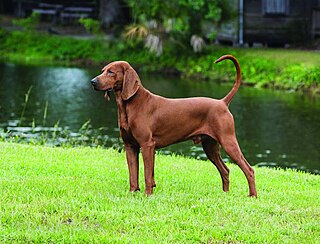
The Redbone Coonhound is an American breed of hunting dog. The Redbone is a courageous hunter often used to track large game such as bear, boar, cougar, though it is also used to track smaller game such as deer. The breed dates back to pre-Civil War and is one of the most versatile of all the hounds. It originated in the Southern United States, and its foundation stock derives from bloodhounds and foxhounds brought by immigrants from Scotland. It is characterized by its deep red coat.
Heraldry in Wales has a tradition distinct from that of English and Scottish heraldry. There is evidence that heraldry was already being used in Wales by the middle of the thirteenth century; for instance, in Gwynedd, two sons of Llywelyn the Great are recorded as having borne coats of arms in this period. Following the integration of Wales into England in the fourteenth and fifteenth centuries, the Welsh heraldic tradition became merged into that of England.

The Southern Hound was a breed of dog that existed in Britain probably until sometime in the 19th century, now extinct. The exact date of its extinction is not known; it is likely that it was gradually interbred with other breeds until the genuine Southern Hound bloodline ceased to exist.
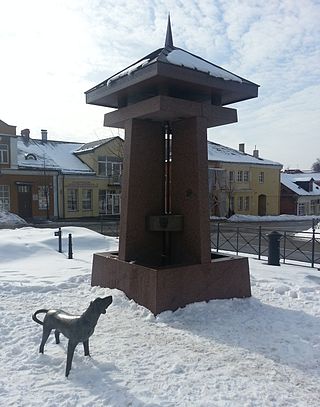
The Lithuanian Hound is a rare, medium-size hunting dog from Lithuania. It is the only dog breed originating from Lithuania and dates back to the medieval Grand Duchy of Lithuania. However, the breed is not recognized by the Fédération Cynologique Internationale (FCI).

Dog types are broad categories of domestic dogs based on form, function, or style of work, lineage, or appearance. Some may be locally adapted dog types that may have the visual characteristics of a modern purebred dog. In contrast, modern dog breeds strictly adhere to long-established breed standards, that began with documented foundation breeding stock sharing a common set of inheritable characteristics, developed by long-established, reputable kennel clubs that recognize the dog as a purebred.
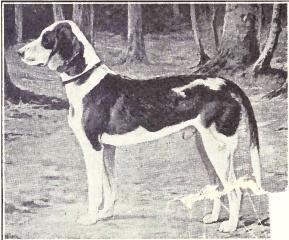
The German Hound is a breed of dog originating in Westphalia, a region of Germany. The German Hound is of the scenthound type, used for hunting both large and small game.

The bloodhound is a large scent hound, originally bred for hunting deer, wild boar, rabbits, and since the Middle Ages, for tracking people. Believed to be descended from hounds once kept at the Abbey of Saint-Hubert, Belgium, in French it is called, le chien de Saint-Hubert.
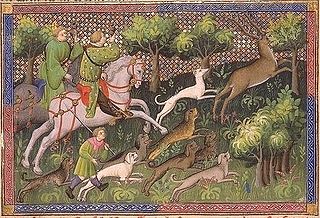
Rache, also spelled racch, rach, and ratch, from Old English ræcc, linked to Old Norse rakkí, is an obsolete name for a type of hunting dog used in Great Britain in the Middle Ages. It was a scenthound used in a pack to run down and kill game, or bring it to bay. The word appears before the Norman Conquest. It was sometimes confused with 'brache', which is a French derived word for a female scenthound.
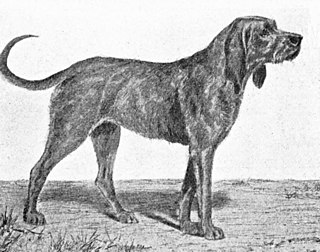
The Chien-gris a.k.a. Gris de Saint-Louis is an extinct breed of dog which originated in Medieval times. Like the Chien de Saint-Hubert, it was a scent hound, and formed part of the royal packs of France, which were composed, from about 1250 till 1470, exclusively of hounds of this type. According to King Charles IX, (1550–1574) they supposedly were introduced to France through Saint Louis, who had encountered these hounds while a prisoner during the Crusades, and subsequently received some as a gift. Old writers on hunting liked to ascribe an ancient and remote origin to their hounds, and these were claimed to be originally from Tartary. They were large, and, even though they did not have such good noses, were preferred by the Kings to the St Huberts, which were said to be only of medium size.
A limer, or lymer, was a kind of dog, a scenthound, used on a leash in medieval times to find large game before it was hunted down by the pack. It was sometimes known as a lyam hound/dog or lime-hound, from the Middle English word lyam, meaning 'leash'. The French cognate limier has sometimes been used for the dogs in English as well. The type is not to be confused with the bandog, which was also a dog controlled by a leash, typically a chain, but was a watchdog or guard dog.

Cultural depictions of dogs in art has become more elaborate as individual breeds evolved and the relationships between human and canine developed. Hunting scenes were popular in the Middle Ages and the Renaissance. Dogs were depicted to symbolize guidance, protection, loyalty, fidelity, faithfulness, alertness, and love.

The Poitevin, also known as the Chien de Haut-Poitou, is a breed of French scenthound from the province of Poitou, this predominantly pack hound was created in the 17th century to hunt wolves.
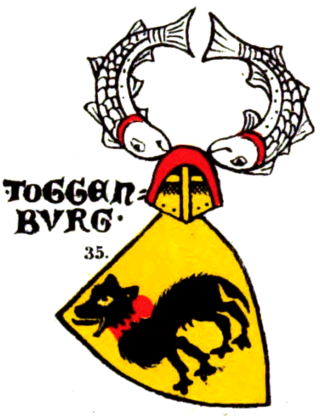
The hound is a charge in classical heraldry. In English heraldry, the commonly used variant are the talbot, also blazoned as sleuth-hound, e.g. in the arms of Wolseley of Staffordshire, the greyhound and bloodhound. Rarely seen variants are the ratch-hound, the mastiff, the foxhound, the spaniel and the terrier. The "sea-dog" is a curious charge resembling the talbot but with scales, webbed feet and a broad tail, used in the arms of Stourton barony, presumably originally depicting a beaver . Similar charges include the wolf and the fox.
The Norman Hound is a now extinct breed of scent hound from France.

Bassets are a sub-type of scenthound deliberately bred with short legs, that are used for hunting where the hunters accompany the hunting hounds on foot.





















